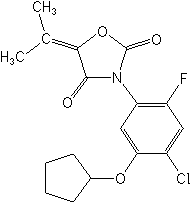-
Common NamePentoxazone
-
中文通用名环戊噁草酮
-
IUPAC3-(4-chloro-5-cyclopentyloxy-2-fluorophenyl)-5-isopropylidene-1,3-oxazolidine-2,4-dione
-
CAS3-[4-chloro-5-(cyclopentyloxy)-2-fluorophenyl]-5-(1-methylethylidene)-2,4-oxazolidinedione
-
CAS No.110956-75-7
-
Molecular FormulaC17H17ClFNO4
-
Molecular Structure
-
Category
-
ActivityHerbicide.Pentoxazone has a bleaching effect when applied to foliage. Kaken reports that in pot tests the product has shown pre- and post-emergence activity. However, pre-emergence activity is at lower use rates. Applications are made before, at or after transplanting. Pentoxazone is safe to rice, although increased phytotoxicity is apparent in deep paddy water. Kaken reports residual activity lasting 50 - 55 days.
Pentoxazone is reported (Japan-Australia Seminar, 2001) to be effective for the control of weeds such as Lindernia spp and Monochoria spp that have developed resistance to sulfonylureas.
Soil metabolism studies (J. Pest. Science, 2002) on 4 different Japanese soils gave similar degradation profiles. The metabolic route was defined by rapid degradation of the parent molecule to N-(4-chloro-5-cyclopentyloxy-2-fluorophenyl)-3-methyl-2-oxobutanamide (A) which accumulated to around 57% of applied radioactivity. This product then degraded to N-(4-chloro-5-cyclopentyloxy-2-fluorophenyl)-2-hydroxy-3-methylbutanamide. Other recorded metabolites included 4-chloro-5-(cyclopentyloxy) -2-fluoroaniline. Further studies in flooded soils confirmed that the major decomposition process was microbial and identified new metabolites: 3-(4-chloro-2-fluoro-5-hydroxyphenyl)-5-isopropylidene-1,3-oxazolidine-2,4-dione and 3-(4-chloro-5-cyclopentyloxy-2-fluorophenyl)-5-isopropyl-1,3-oxazolidine-2,4-dione in addition to (A). The rate of degradation in flooded soils was slower than in the aerobic soil tests.
In the US an MRL for pentoxazone in rice has been set at 0.1 ppm. -
CropUseCropUses:
Rice
Rice
150 - 450 g ai/ha
-
PremixGranule, suspension concentrate, water dispersible granule. Premix Parters: chloridazon desmedipham; chloridazon quinmerac; desmedipham; desmedipham ethofumesate; ethofumesate; ethofumesate lenacil; ethofumesate metamitron;
Type
AI concn
Granule (GR)
1.5% (w/w)
Suspension concentrate (SC)
8.6% (w/v), 2.9% (w/v)
-
Physical PropertiesMolecular weight:353.8; Physical form:Colourless, odourless, crystalline powder. Density:1.418 (25 °C); Melting point:104 °C; Vapour pressure:<1.11 × 10-2 mPa (25 °C); Henry constant:<1.82 × 10-2 Pa m3 mol-1 ( calc.); Solubility:In water 0.216 mg/l (25 °C). In methanol 24.8, hexane 5.10 (both in g/l).; Stability:Stable to heat, light and acid; unstable in alkali.
-
ToxicologyOral:Acute oral LD50 for male and female rats, and male and female mice >5000 mg/ kg. Percutaneous:Acute percutaneous LD50 for male and female rats >2000 mg/kg. Not a skin or eye irritant (rabbits); not a skin sensitiser (guinea pigs). Inhalation: LC50 (4 h) for male and female rats >5100 mg/m3.
-
Environmental ProfileEcotoxicology:
Bobwhite quail
LD50 2,250 mg/kg
Rainbow trout [96 h]
LC50 >40ppm
Carp
TLm96 22 ppm
Daphnia
TLm24 >100 ppm
Honeybee
LC50: >800ppm (48h)
Silkworm
LC50 >458ppm (96h)
Earthworm
LC50: >851 ppm in dry soil (14 days)
Fate in soil:
The soil half-life is dependent on the number of applications made and varies from 5 - 23 days following a single application to 10 - 40 days following two applications.Fate in aquatic systems:
The half-life of pentoxazone in paddy water is 5 days. -
Transport InformationHazard Class:O (Obsolete as pesticide, not classified)
Porduct NewsMore
Pentoxazone to be Registered for Sale in China
Pentoxazone herbicide got first registration in China

 0
0 Subscribe
Subscribe
